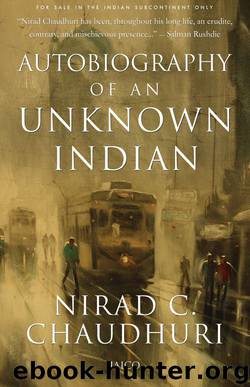Autobiography of an Unknown Indian by Nirad C. Chaudhuri

Author:Nirad C. Chaudhuri [Chaudhuri, Nirad C.]
Language: eng
Format: azw3
Tags: Autobiography of an Unknown Indian
Publisher: South Asia Books
Published: 2018-05-10T16:00:00+00:00
Chapter I
CALCUTTA
Calcutta Grew enormously during the thirty-two years I lived in it, and became amorphous. Since 1942 it has received hundreds of thousands of additional immigrants and, according to old residents, is no longer recognizable as its familiar self. I have not seen Calcutta after this recent adulteration, but even in 1910 it was not one city. In certain of its quarters a man could easily fancy that he was in China. Other parts looked like mohallas torn out of the cities of upper India, and, in fact, till recently Calcutta had the largest Hindi-speaking population of any city in India. Along the Chowringhee and south of Park Street the city had an appearance which probably was not materially different from that of the European adjuncts of Chinese, Malay, or Egyptian ports, but even here it did not exhale mere commerce, club life, sport, and turf. Those who were historically conscious could sense these parts of Calcutta to be very perceptibly breathing the spirit of the builders of the British Empire in India. The rest of the city was purely Bengali.
"Between the European and the Bengali parts, however, there always was a Eurasian and Muhammadan belt, very characteristic in appearance and still more so in smell. One of the typical sights of these quarters were the butcher’s shops with beef hanging from iron hooks in huge carcasses, very much bigger than the goat carcasses to whose size we the Bengali Hindus were more used. These wayside stalls were redolent of lard, and were frequented by pariah or mongrel dogs of far stronger build and fiercer looks than the dogs of the Hindu parts of the city. These animals always reminded me of the dogs in the butcher’s shops of the Arabian Nights. All the components of Calcutta had personality and character, but the foreign elements seemed to be even more particularly assertive. In spite of the numerical preponderance of Bengalis the city was, and perhaps still is, an international concession, once flourishing but now moribund, on the mud flats of deltaic Bengal.
Even when we first came to it Calcutta was vast. At the same time it was very close-knit and compact. It was not broken in relief like Rome with its seven Hills, nor scattered in space like Delhi with its seven historic sites. That did not mean, however, that from a height the city had a smooth appearance. Looked at from the top of the Ochterlony Monument, or even from the roof of a high private house, the house-tops of Calcutta seemed in their crowded and untidy rows to bid the most solid and the ugliest imaginable defiance to the sky. They made a deep impression on me when I contemplated them with the newly acquired sense of being a citizen, immediately after our arrival in 1910. Our house, which was in the Bowbazar quarter, was a four-storied building, and as we went up to its roof an amazing confusion met our eyes. There was an immense expanse of
Download
This site does not store any files on its server. We only index and link to content provided by other sites. Please contact the content providers to delete copyright contents if any and email us, we'll remove relevant links or contents immediately.
| Africa | Asia |
| Canadian | Europe |
| Holocaust | Latin America |
| Middle East | United States |
Fanny Burney by Claire Harman(26532)
Empire of the Sikhs by Patwant Singh(22983)
Out of India by Michael Foss(16793)
Leonardo da Vinci by Walter Isaacson(13190)
Small Great Things by Jodi Picoult(7027)
The Six Wives Of Henry VIII (WOMEN IN HISTORY) by Fraser Antonia(5404)
The Wind in My Hair by Masih Alinejad(5036)
A Higher Loyalty: Truth, Lies, and Leadership by James Comey(4853)
The Lonely City by Olivia Laing(4753)
The Crown by Robert Lacey(4732)
Millionaire: The Philanderer, Gambler, and Duelist Who Invented Modern Finance by Janet Gleeson(4387)
The Iron Duke by The Iron Duke(4296)
Papillon (English) by Henri Charrière(4200)
Sticky Fingers by Joe Hagan(4106)
Joan of Arc by Mary Gordon(4025)
Alive: The Story of the Andes Survivors by Piers Paul Read(3970)
Stalin by Stephen Kotkin(3885)
Aleister Crowley: The Biography by Tobias Churton(3590)
Ants Among Elephants by Sujatha Gidla(3420)
